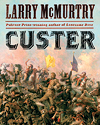
Custer, by Larry McMurtry, Simon & Schuster, New York, 2012, $35
In the wake of such monumental books on George Armstrong Custer by writers like Frederick Whittaker, W.A. Graham, Jay Monaghan, Robert M. Utley, Evan S. Connell, James Donovan and Nathaniel Philbrick, what else could Larry McMurtry say? Plenty. The prolific Pulitzer- and Oscar-winning writer tackles the Boy General and the Battle of the Little Bighorn in this “short” history.
Though best known as a novelist (The Last Picture Show, Terms of Endearment, Lonesome Dove), McMurtry has also penned brief nonfiction books about Western figures (Crazy Horse: A Life, The Colonel and Little Missie: Buffalo Bill, Annie Oakley and the Beginnings of Superstardom in America). Clocking in under 300 pages, Custer is rich in illustrations and in McMurtry’s pontifications. One photo is captioned “Custer With His Horse, Comanche,” but Comanche belonged to Captain Myles Keogh, and it is enlisted man Gustave Korn that holds the horse in the photo. McMurtry covers little new ground, and while this book is rather sloppy for a writer of his stature, it does offer insight when he puts history in contemporary context.
While writing a screenplay in southern Montana in the late 1970s, McMurtry spent time on the Crow and Cheyenne reservations and astutely noticed the following difference between the Crows, who served as Army scouts, and the Cheyennes, who fought alongside the defiant Lakotas against Custer: “In two weeks on the Cheyenne reservations I had maybe two conversations,” the author writes. “In one day on the Crow reservation I had at least a dozen.” Custer scholars might scoff at McMurtry’s history, but he certainly has the ability to put the legendary, controversial figure before the masses—one more time.
Johnny D. Boggs




